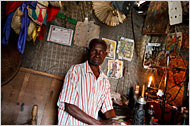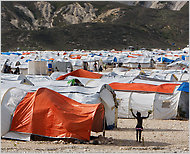
Ruth Fremson/The New York Times
Hundreds of families live on the median strip of a road in the Port-au-Prince area.
By
DEBORAH SONTAG
Published: July 10, 2010
· Recommend
·
· Share
o
Multimedia
Seeking Shelter in Haiti
The Port-au-Prince Area
Ruth Fremson/The New York Times
A planned tent city in Corail-Cesselesse, about 10 miles north of Port-au-Prince, is now home to about 5,000 displaced people whose previous camp was at risk from flooding or landslides.
Readers' Comments
Readers shared their thoughts on this article.
Vehicles rumble by day and night, blaring horns, kicking up dust and belching exhaust. Residents try to protect themselves by positioning tires as bumpers in front of their shacks but cars still hit, injure and sometimes kill them. Rarely does anybody stop to offer help, and Judith Guillaume, 23, often wonders why.
“Don’t they have a heart, or a suggestion?” asked Ms. Guillaume, who covers her children’s noses with her floral skirt when the diesel fumes get especially strong.
Six months after the earthquake that brought aid and attention here from around the world, the median-strip camp blends into the often numbing wretchedness of the post-disaster landscape. Only 28,000 of the 1.5 million Haitians displaced by the earthquake have moved into new homes, and the Port-au-Prince area remains a tableau of life in the ruins.
The tableau does contain a spectrum of circumstances: precarious, neglected encampments; planned tent cities with latrines, showers and clinics; debris-strewn neighborhoods where residents have returned to both intact and condemnable houses; and, here and there, gleaming new shelters or bulldozed territory for a city of the future.
But the government of Haiti has been slow to make the difficult decisions needed to move from a state of emergency into a period of recovery. Weak before the disaster and further weakened by it, the government has been overwhelmed by the logistical complexities of issues like debris removal and the identification of safe relocation sites.
In some cases, the government has also been politically skittish about, say, creating new slums or encouraging people to return to undamaged homes when the ground beneath them could move again.
In others, it has taken charge but gotten bogged down. Since early May, President René Préval has personally focused, in granular detail, on returning about 11,600 Haitians camped in front of the National Palace to the Fort National neighborhood. But while Fort National is now a beehive of cleanup activity, no transitional shelters have been erected there yet.
In contrast, the Adventist Development and Relief Agency, working directly with a hands-on mayor in the Carrefour municipality in metropolitan Port-au-Prince, has already moved more than 500 families from its large tent city into simple pine houses whose concrete foundations incorporate recycled debris.
“Even though I lost my mom in the earthquake, I feel so content, so comfortable and so lucky to have this place,” Ketly Louis, 33, said, welcoming visitors into her new home on the site of the old home that collapsed on her mother.
International organizations here, while empathetic because of the difficulty of issues like land ownership, criticize the government for creating obstacles of its own. Significant delays in clearing supplies through customs, for instance, slow recovery efforts even as they earn the government substantial fees for storage.
And with hurricane season under way and many tents and tarpaulins needing replacement or reinforcement, some humanitarian groups complain about what they see as the government’s failure to articulate a clear resettlement strategy.
“Everywhere I go, people ask me, ‘When will we get out of this camp?’ ” said Julie Schindall, a spokeswoman in Haiti for the international aid group Oxfam. “And I have no answer. There needs to be communication on how all this camp business is going to be resolved.”
Haitian and United Nations officials urge patience in the aftermath of what they call the largest urban disaster in modern history. They point to accomplishments in providing emergency food, water and shelter and averting starvation, exodus and violence.
“What hasn’t happened is worth noting,” said Nigel Fisher, deputy special representative of the United Nations secretary general in Haiti. “We haven’t had a major outbreak of disease. We haven’t had a major breakdown in security.”



